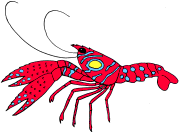
Enoplometopus occidentalis (Randall, 1840)
ILLUSTRATIONS. - • Specimen from Taiwan; after Chan & Yu (1993: 102), photo P.H. Ho.. Copyright Chan/Yu/Ho. • Specimen from Indian Ocean, after Debelius (1984: 37), photo Kuiter. Copyright H. Debelius/Kuiter. • Specimen from Pacific, after Debelius (1984: 36), photo Newbert. Copyright H. Debelius/Newbert.
REFERENCES. - Nephrops occidentalis Randall, 1840 (Type locality: "brought from the west coast of North America by Mr. Nuttall"; however, according to most authors, this indication is obsviously erroneous and type locality is almost certainly the Hawaiian Islands).
Enoplometopus occidentalis - Rathbun, 1906: 900 (Hawaii). - Bouvier, 1915: 182 [5] (Mauritius). - Holthuis, 1946: 74 (Ambon). - Barnard, 1950: 532 (Natal). - Gordon, 1968: 95 (Mombasa). - Tinker, 1965: 40 (Hawaii). - Healy & Yaldwyn, 1970: 56 (Heron Island). - Crosnier, 1977: 237 (Réunion, Madagascar). - Daum, 1982: 266 (Sydney Harbor). - Miyake, 1982: 78, pl. 26 (Japan). - Debelius, 1984: 36, 37 (Illustration). - Fielding, 1985: 86 (Hawaii). - Takeda, 1986: 106 (Japan). - Fielding & Robinson, 1987: 80, photograph 68 (Hawaii). - Nomura et al., 1988: 42 (Japan). - Chan & Yu, 1993: 102 (Taiwan). - Allen & Steene, 1994: 145 (Illustration). - Debelius & Baensch, 1994: 591 (Illustration). - Colin & Arneson, 1995: 224, photographs 1066, 1067 (Indonesia, Hawaii). - Gosliner et al., 1996: 220, photograph 796 (Hawaii). - Hoover, 1998: 241 (Hawaii).
Enoplometopus (Enoplometopus) occidentalis - Holthuis, 1983: 294 (Amirante Islands, Ambon, Hawaii). - Hayashi, 1995: 338, pl. 91–1 (Japan).
Enoplometopus pictus - Miers, 1880: 380 (Ambon). - De Man, 1888: 486 (Ambon) - [Not Enoplometopus pictus A. Milne Edwards, 1862].
Enoplometopus longirostris De Man, 1888: 488 (Ambon). - De Man, 1921: 94; 1922: 50 (Java Sea, Banda Sea). - Holthuis, 1946: 84 (Celebes, Moluccas) [E. longirostris is a postlarval stage, possibly of E. occidentalis; cf. Holthuis, 1983: 281].
Enoplometopus sp. - Colin & Arneson, 1995: 224, photographs 1066 (Indonesia).
Not Enoplometopus occidentalis - ? Kubo, 1952: 97 (= possibly E. debelius Holthuis, 1983). - George & George, 1979: 78 (= Enoplometopus holthuisi Gordon, 1968).
Additional references in: Barnard (1950: 532), Holthuis (1946: 74; 1983: 294).
LOCATION OF TYPES SPECIMENS. - Academy of Natural Sciences of Philadelphia (ANSP) (cf. Spamer & Bogan, 1992: holotype ANSP CA288, previous no. 132). "The specimen is partly disarticulated" (com. pers. Spamer 11/03/2002).
MATERIAL EXAMINED. - West Indian Ocean: Madagascar: coll. R. Plante, det. A. Crosnier, South of Madagascar 26°05'S, 44°50'E, trawl 100 m, 1 male juvenile cl 13 mm (MNHN As 628). - Réunion: coll. Y. Plessis 1973, det. Th. Monod, 1 male cl 25 mm, 1 female cl 20.5 mm, 1 ovigerous female cl 28 mm (MNHN As 272); coll. P. Guezé, det. A. Crosnier, trap ?350 m, February 1974, 1 male cl 33.5 mm (MNHN As 555), 1/071973, net 100 m, 1 male cl 39.5 mm (MNHN As 559). - Mauritius: Port Louis, coll. P. Carié 1910, 1 male cl 22.5 mm (MNHN As 52), coll. P. Carié 1913, 1 male cl 19 mm (MNHN As 53; dry) (these 2 sp. studied by Bouvier 1915), coll. P. Carié 1910, 1 female 32.5 mm (MNHN As 54). - Philippines: Manilla, coll. C. Vadon 1980 "aquarium, Manille ?", 1 male cl 23 mm (MNHN As 557). - New Caledonia: Loyalty Islands, Ouvéa, "ilôt Bagat", coll. J.P. Menou 18/11/1991, dive 9–11 m, 2 females cl 14–16.5 mm (MNHN As 577, photo CB1049); coral grounds ("Patate sur fonds blancs"), 21/03/1990, coll. Tirard, 1 female cl 38 mm (MNHN As 566). - Central Pacific: Hawaii, coll. Baillieu "2529–1878", 1 male cl 43 mm (MNHN As 55).
CARAPACE. - Lateral edge of rostrum with two spines (large specimens with only 2 spines on each edge; smaller specimens with 3–4 spines). Carapace armed with five median spines (anterior spine blunt); one postcervical spine; three lateral spines, or four lateral spines; two intermediate spines; one supra-ocular spine.
CHELIPEDS (P1) & AMBULATORY LEGS (P2 to P5). - Chela broad and compressed, about 3 times as long as wide; dactyl of cheliped with spines and tubercles on outer margin; 2 or 3 distal spines, behind which the margin is smooth or with low blunt tubercules; upper and lower faces of chela with tubercles (with a rather distinct median longitudinal row). Dactyl of second pereiopod long, about 0.3 times as long as propodus; carpus with a distoventral spine.
ABDOMEN & TELSON. - Pleurae of abdominal somites II to V rounded or bluntly pointed. Anteroventral margins of pleurae II to V smooth. Posterior margin of sixth abdominal tergite smooth or tuberculated, but without true spines. Male first pleopod without distal or subdistal indentation. Telson with one lateral spine; and three distolateral spines.
COLORATION. - Ground color of body orange red. Lateral face of carapace with one or two ocellated spot (white spot circled with orange). Ambulatory legs orange red with narrow white bands. Abdomen with several ocellated spots (white spots circled with orange).
DISTRIBUTION. - West Indian Ocean: South Africa (Natal), Kenya (Mombassa), Madagascar, Réunion, Mauritius (Port Louis), Seychelles (Amirante Islands). Indonesia: Java sea, Celebes (Menado), Moluccas (Ambon, Banda, Ternate); East Australia: Great Barrier reef (Heron Island), Sydney harbor. West Pacific: Japan, Taiwan; Central Pacific: Hawaii Islands (Hawaii, Maui, Oahu). Deep distribution: 0–100 meters (cf. Chan & Yu, 1993: 103).
REMARKS. - Enoplometopus occidentalis is the most common species in the Indo-West Pacific.
Cite this publication as: Joseph POUPIN (2002 onwards).Tropical reef lobsters of the genus Enoplometopus: Descriptions, Illustrations, Identification, and Information Retrieval, using the DELTA format. Version: 30 May 2002. At http://biomar.free.fr/enoplometopus/.